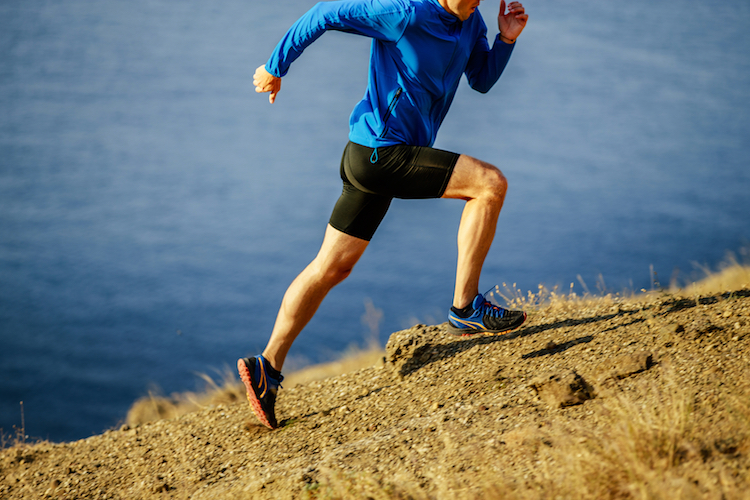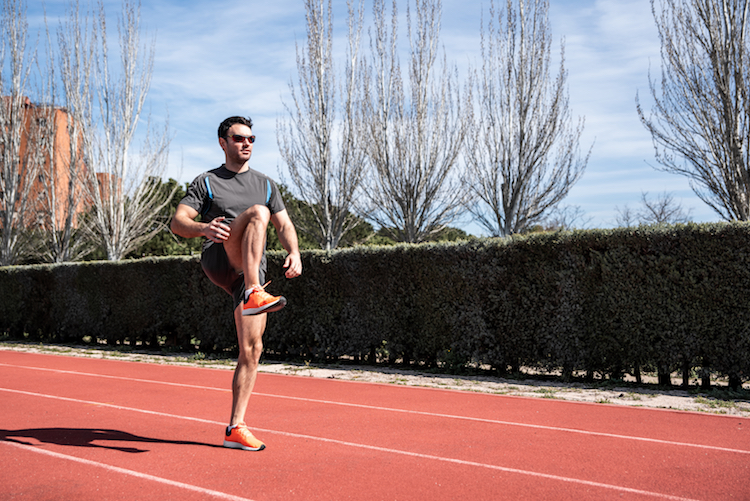In the good old days when your gym was open, you reliably strolled past the treadmills every morning to go right to the strength floor. Now, your barbells aren’t available to you, and instead of associating running with the long slog of the cardio deck, you’ve started to associate running with the sweet and rare sensation of… being outside.
In a lot of places, exercise is one of the only ways you can really spend time out of the house these days, so many people — yes, even serious lifters — are turning to jogging as a way to keep the pandemic blues away.
If you’re one of those new joggers (you can admit it, this is a safe space), you’re probably worried about what impact all that running might have on your muscle mass. You’ve heard the rumors about how running can take away from your size gains, and you keep picturing the difference between the quintessential marathon runner versus the quintessential sprinter’s body.
If you’re worried about your muscles withering away because you’re jogging during the pandemic, rest assured — your muscles won’t disappear. As long as you’re doing it right.
[Related: Could Jogging Actually Help You Get Stronger?]

Steady-state cardio has a pretty brutal reputation in strength circles, but that doesn’t mean a few slow jogs a week will kill your squat goals.
Sure, you probably don’t want to run a 5k before you go for a max-effort squat (unless you’re training to be a multi-sport athlete… in which case, you’re probably already convinced that steady-state and strength work can be happily married). But if you get your timing right and dial in your nutrition, you’ll be able to build a solid aerobic base that will help you not feel quite so near-death as you do after an eight-rep set.
The more you increase your work capacity, the better you’ll be able to recover from heavy lifting sessions — and the better you recover, the better you train. The better you train, the more you can lift. In that way, as long as you’re doing it right, running can actually bolster your strength gains and muscle mass development.
Now is an especially great time to get into the aerobic game. Most states don’t have gyms re-opened yet — and even for those that do, you might want to avoid them for a while (especially if you’re immunocompromised and/or have friends and family who are high risk). Running will get you outside (excellent for your mental health, which will only help your strength and muscle maintenance goals) and develop muscles you never even knew you had.
Even if you don’t plan to trade in your Metcons for running sneakers after you get back to the gym, you might find that using this time to improve your aerobic capacity is exactly the training element your program has been missing.
Proper Running Form
Especially if you’re a heavier lifter, you want to make sure you’re not going to do damage to your joints with all the repetitive stress — and while everyone’s body is different, the quickest ways to guarantee you’ll get hurt is to (a) run with crappy form and (b) ramp up too quickly.
- Avoid striking with your heel (seriously — it might feel counterintuitive to strike with the ball of your foot at first, but just… don’t heel strike. Your plantar fascitis will hate you)
- When your foot hits the pavement, it should be aligned under your knee.
- Your hips should lean very slightly into your run, but keep your spine nice and tall.
- Keep your hands relaxed and your arms at about a 90-degree angle.
- Avoid hunching your shoulders forward, and keep your gaze directly in front of you.

Running Frequency For Lifters
Once you’ve got all that down, please oh please don’t run with your ego. Just because you can throw a few plates on a bar and squat the crap out of it doesn’t mean you can suddenly run a 5 or 10k.
Take it slow, in all ways: with your pace, your mileage, and your frequency. Start out a couple of times a week, and take your runs nice and easy. Think of it in terms of linear progression: yes, you want to be gradually increasing your stamina and running strength, but you only want to alter one variable at a time. Running faster today? Don’t also run longer. Running longer? Keep a slower pace.
Your muscles won’t melt away if you ramp it up (eventually) to jogging three or four times a week. As long as you get in the habit of programming it right, these runs will actually help you recover from heavy lifting sessions once you do get back to the gym.
Improving Mobility
If you’re not already programming ankle flexibility work into your strength program, you should be — your squat will thank you, and so will your knees and hips. As you start integrating running into your strength program, it’ll become even more critical for injury-prevention to incorporate flexibility, mobility, and balance work into your routine.
Long lunges and slow, single-leg deadlifts without weights are your friends, as are lateral lunges and butterfly stretches. Don’t skimp on these — they’ll help stave off injury during your runs and they’ll help fix your good morning squat, so you’ve really got no reason to skip this essential work.

Running Programming For Lifters
While you’re training from home, it can be hard to maintain the training split that you might normally have at the gym — but if you’ve been keeping some relative consistency, you might be hitting your legs extra hard on certain days (pistol squats and Bulgarian split squats on your dining room chair #forthewin). You might not want to program a long run before those days, because you don’t want your legs to still be recovering on leg day. (Split squats are evil enough as it is.) On the flip, programming a longer recovery jog for the day after you’ve hit your legs hard (whether at home or in the gym) can help you expedite your recovery and get back to squatting more efficiently, sooner.
If you’re putting sprints or hill runs into your program, make sure you ramp up to it first. Develop a solid aerobic base from at least a couple weeks of jogging with impeccable form before you start integrating speed or hill work. Once you’re ready, treat these days like you would leg days — when you go hard, as with sprints and hill runs, you’ll need to let your muscles and your CNS recover. To maximize the amount of work you can get done in a week, you might want to do some sprints or hill work after your heavy lower body workouts (same day) — that way, you’ll recover from both together. If you’re going to do this, though, make sure you’ve prepped your body for it — that always includes stretching and mobility work, folks.
Remember as you’re programming that a long run to you might be a short run to someone else, and that is okay. If a mile is a long run for you, then a mile is a long run for you — judge by your body, not anyone else’s. Similarly, if your sprinting is someone else’s warmup (my sprinting is easily my wife’s 5k pace), that’s alright. Meet your body where it’s at, and you’ll improve with time.

Eat Enough
If you’re looking to maintain muscle mass while running, you have to make sure you’re giving your body what it needs. Focus your protein intake just like you would while you’re training — your muscles still need fuel, especially now that you’re expanding your repertoire to include both strength training and running.
[Related: Try our macros calculator to learn the ideal amount of calories and protein your body needs]
Keep Strength Training
If you don’t have access to your gym, you might indeed lose some strength or muscle mass from the loss of sheer weight on your back.
But the losses don’t have to be dramatic.
As you start to incorporate running into your strength routine, make sure you’re, you know, maintaining your strength routine. While you have access to the gym, that includes your big three and overhead presses. While you’re at home, it probably includes a lot of eccentric work, filling your backpack with college textbooks and doing pushups; doing inverted rows with a bedsheet secured in a doorframe; and (if you don’t live above your neighbors) a lot of plyometric work. If you do live above neighbors, play with tempo to mimic the effects of plyo exercises — instead of a jump squat, for example, sink into your squat with a slow, slow count of four or five, then explode back up in a quick second, perhaps even letting yourself rise to your tiptoes.
Whatever your strength training situation (praise the strength training gods if you’ve been able to get your hands on a kettlebell during the pandemic), make sure that you keep it up while you’re running. Be smart about your programming, make sure you’ve got enough time and space to recover from your work. Have as much fun as you can getting to know your body in entirely new ways, keeping strength training as a solid base.
[Relate: 3 reasons to perform cardio after lifting]

Run Hills
Especially if you’re just starting to get your form and aerobic base down, you don’t want to find the steepest hill in your neighborhood and go. (Seriously. Please don’t do that. No ego running, remember? You want to ultimately benefit your lifts and muscles, not injure yourself so you can’t even strength train.)
But if you’re ready — if you can jog continuously on relatively flat ground for 15-20 minutes without feeling super winded — pick a hill and jog. After warming up, go at a reasonably hard pace (think RPE about 6 or 7) up the hill for 45 seconds. Take your time walking down, regulating your heart rate by trying to stay upright, inhaling and exhaling through your nose. Next, head back up the hill for 15 seconds at an RPE of about 8 or 9. Rinse and repeat four times per interval.
This is one of those runs that will help develop your leg muscles, sprint-style — so again, treat it like a lower-body/leg day and make sure to let yourself recover. Just because this will be a no-brainer for maintaining and even building muscle mass doesn’t mean you can or should do it every day. Slow jogs in between will make you better at this, and that will only improve your muscle-y-ness with time. So ramp up slowly and take your sweet time recovering.

Try Fartlek
As a lifter, you might be super intimidated by the idea of sprinting — because let’s face it, you tend to consider a set of eight reps cardio.
Fartlek runs are a nice way to ease into sprinting, because you’ll incorporate speed work into an otherwise slowish tempo run. After you warm up, run easy for about a minute. Then go hard (not a full sprint, but a solid run) for about a minute. Slip back into a jog, then back into a run. If you’d prefer to use time as your marker, alternate between a minute hard, a minute slow, 30 seconds hard, 30 seconds slow, etc. If you want to get more creative, say to yourself, “okay, I’m gonna run hard until that stop sign,” etc., picking new goals based on your environment as you go.
If you’re one of those lifters who tends to think of running as boring, this is a great method for bursting out of the boredom and developing your muscle mass at the same time via the sprint components.

Listen To Your Body And Get Jogging
As you get out onto the trail, make sure you’re paying attention to your body. If you’re finding it hard to breathe during your run, slow the heck down. If there’s sharp pain, call it a day. If you’re suddenly finding your strength workouts way harder than they normally are, dial back the intensity of your runs. If that doesn’t work, try switching the days you’re running. Make sure you’re eating enough and sleeping enough.
Just like you probably take notes on your strength training, take careful notes of your running journey — listening to your body is one of the greatest tricks of the trade for maximizing muscle mass retention and development while running, with or without access to weights.
Featured image via Carlos Pintau/Shutterstock